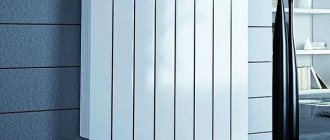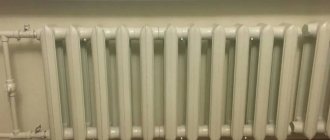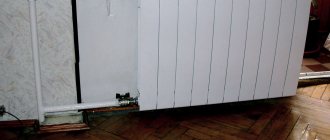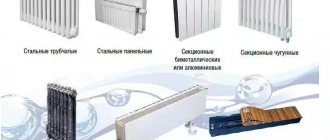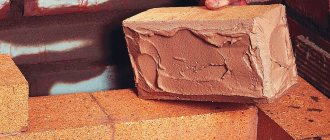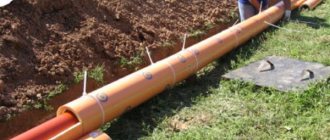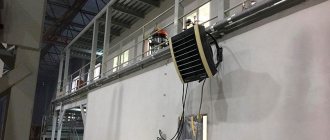At the very beginning, you need to find out how much primer solution and paint you need to use to paint the battery. This can be found out by calculating the area of the heating radiator. Next, look at the recommendations indicated on the paint can. They always indicate how much paint can be used per 1 square meter. m . It is impossible to measure the battery area yourself. This does not need to be done, because manufacturers indicate the heating surface area of the section. Since every square centimeter of the section is heated, this area and the area of the entire surface of the section. One edge of the MS-140-500 battery has an area of 0.244 square meters. m. A modification of this model with an interaxal distance of 300 mm has sections with an area of 0.208 sq. m.
To determine the total surface area of a cast iron battery, you must:
- Find out the model name of the installed battery and preferably the manufacturer (this is because sections produced by manufacturers of the same models have different depths and widths).
- Set the heating area of 1 rib.
- Multiply the number of sections by the area. If the MS-140-500 radiator has 10 fins, then the surface area will be 2.44 square meters. m.
Having made the calculation, they determine the amount of composition and primer, buy them and paint. Paint should be taken with reserve, because everyone applies a layer with a different thickness.
Preparatory activities
They involve cleaning the surface of the battery from old paint and dirt:
Carefully wipe off the dust with a damp cloth so that no dirt remains in the recesses. To clean hard-to-reach areas, place a rag between the ribs and move it back and forth.
- Remove the layer of old paint. When using a chemical method, Dufa, SP-6, B52, ACE products are used, but they are not able to cope with oil compositions that were produced in the mid-20th century. The physical method requires the use of a drill with a metal brush attached. You can also use a file and sandpaper.
- Apply a layer of primer mixture. It must not only withstand elevated temperatures, but also match the type of paint, it’s good if they are the same brand.
The beauty of the heating device can be easily restored by painting the surface of the cast iron radiator.
At the very beginning, you need to find out how much primer solution and paint you need to use to paint the battery. This can be found out by calculating the area of the heating radiator. Next, look at the recommendations indicated on the paint can. They always indicate how much paint can be used per 1 square meter. m. Manufacturers indicate the heating surface area of the section.
To determine the total surface area of a cast iron battery, you must:
- Find out the model name of the installed battery and the manufacturer (because sections produced by manufacturers of the same models have different depths and widths).
- Set the heating area of 1 rib.
- Multiply the number of sections by the area. If there are 10 fins in the MS-140-500 radiator, then the surface area is 2.44 square meters. m.
Having made the calculation, determine the amount of composition and primer. Paint should be taken with reserve.
They involve cleaning the surface from dirt and old paint. Preparation proceeds as follows:
Get rid of the old layer of paint. This can be done chemically or physically. The first involves the use of Dufa, B52, SP-6, ACE solutions. They are powerless against oil compounds made in the 50s of the twentieth century. The physical method is to use a drill with a metal brush attached to it. You can use sandpaper and a file. If chemicals were used, the cast iron will have to be cleaned with a wire brush mounted on a drill. Rusty areas are treated with sandpaper.
Apply a layer of primer. It must withstand high temperatures and match the type of paint. It is better if the brand of both is the same.
It can be carried out using any type of composition, but under one condition: the solution must be resistant to high temperatures.
The dyeing process is as follows:
- Use a flexible brush to update the appearance of hard-to-reach places (they are located between the pipes of the sections). In some parts the brush will not touch the cast iron. You can use gauze folded into a tourniquet. It is placed between the sections, paint is applied to the middle and then the ends are pulled in turn. This way the paint will adhere to the alloy.
- Paint the top and easily accessible places.
- Always moving from top to bottom. It is better to apply the paint in several layers.
How to independently calculate the coverage area and paint consumption
There are various ways to calculate the painting area of cast iron radiators, but there is no use in “reinventing the wheel”.
Attention! Manufacturers of thermal equipment reflect this information in the technical description for the model. This value is usually indicated as “heating area”; other options and translations are possible if these are imported models.
When calculating the paint area of a cast iron radiator MS-140 as a classic model, we take into account the area of one section or “accordion fin”. It is approximately equal to 0.244 m2. A more modern or modified section with a slightly larger center distance (300 mm) has a painting area of about 0.208 m2.
The radiator can be painted in any color that matches the overall interior
Models of cast iron batteries can vary greatly, so for calculations we take the heating area of one section from the documentation (product data sheet). Next, we multiply by the total area of all ribs with a small margin (adapters, taps, couplings, legs). For example, in the standard MS-140-500 there are 10 ribs, multiply by 10 the section area of 0.244 sq.m. We get 2.44 m2. Round up to 3 m2 - for all adjacent parts. Next we decide how many layers of painting there will be.
Coating process
Initially, it turned out that domestic heating radiators look a little rough and old-fashioned, but if you properly treat the surface and choose an interesting design, the devices will please the eye for a long time. The following instructions will help you carry out the work without professional help.
General provisions
First, preliminary recommendations should be considered to ensure a high-quality coating application, after which one should proceed to study the sequence of actions.
As for tools, you will need a simple painting kit for the work.
Painting: a – use a brush, b – use a special spray can.
- As the main equipment, it is recommended to use a small smooth roller made of foam rubber and a brush necessary for treating hard-to-reach places. If necessary, the battery can be removed to provide access to certain areas.
- The paint coating is applied only to a cold device, otherwise problems with peeling off the dried composition cannot be avoided. Therefore, it is advisable to carry out such activities when the heating season is not in progress. However, you can always close the valves, stopping the flow of hot water.
- To determine the approximate painting area of cast iron radiators, you need to multiply the length by the width and multiply by two, then add ten percent to the result. The final number will be the approximate square footage of the cast iron panel.
- It is best to apply paint to fixed batteries from above, this way you will be able to avoid accidental smudges. Experts recommend not limiting yourself to one layer, because in two passes it is easier to provide high-quality surface protection.
Removing a cast iron heating radiator for painting.
Attention! Heating of heating radiators is allowed only after the paintwork has completely dried, otherwise streaks, stains or small bubbles may appear
Procedure
When the area to paint the cast iron radiator section has been determined and the necessary materials have been purchased, you can begin the main work, which cannot be classified as complex work. It is enough to adhere to a certain sequence of actions, and also be able to use a brush and roller.
When removing a heating device, you can use a spray gun.
This is how the treatment is carried out using a spray gun.
- The first stage usually involves cleaning the surface of the deteriorated coating using chemical solvents or a wire brush. In the first case, the dried layer is washed off with a special mixture, and in the other, mechanical removal is performed, in which a drill can be used.
- After successfully removing the old paint, the battery surface is subjected to a degreasing process, which removes organic contaminants from the device. An ordinary solvent can be used as the main agent.
- Next, the heating device is treated with a primer, which ensures high-quality adhesion. That is, the adhesion of paint to the surface becomes much better. This composition is applied using traditional painting tools.
- Using a foam roller, the main planes of the sections are first processed, after which hard-to-reach areas are passed with a brush. If a spray gun is used during the work, then the listed equipment is not required. After the first layer has dried, the next one is applied.
Note! When using mechanized equipment, the coating is applied to a higher quality, but the price of such devices is usually quite high, so many craftsmen use a brush and roller in the process.
Remove from wooden surface
The main feature of working with wood is that it is a soft material that is easily damaged if treated carelessly.
Having decided to remove the old paint layer from furniture or another wooden surface, first of all you need to understand whether this is necessary
If the old coating is applied in a thin layer and does not have serious damage, you can simply apply a protective primer on it and start painting. Attention! If the coating is in poor condition, it must be removed. This must also be done if it differs in composition from the new paint and is incompatible with it. If these rules are not followed, both layers may eventually be destroyed.
If these rules are not followed, both layers may eventually be destroyed.
Old one from the floor
Methods for removing old paint from a floor vary depending on what material it is made of and whether the coating has had time to dry.
So, the most effective way to remove dried paint from linoleum is to cut it off with a sharp knife. If the layer is too thin, use a wire brush or scraper. In this case, you need to act carefully so as not to damage the floor. To make the paint come off easier, cover the stain with a cloth soaked in acetone and leave for 10 minutes.
There are two methods used to clean porcelain stoneware:
- Mechanical;
- Chemical.
The first involves scraping off the paint using a knife, spatula or other tools by hand.
In this case, do not use sandpaper, metal brushes or other abrasives that can scratch the material.
In the second case, chemicals are used that are designed to remove such compounds.
Today there are special cleaners for porcelain tiles on sale that allow you to remove traces of a wide variety of stains.
This is interesting: How long can you store various foods in the refrigerator?
If you need to get rid of old paint on laminate flooring, use White Spirit, solvent or another product with a similar effect. However, keep in mind that they can also have an aggressive effect on the laminate itself, leaving marks on it. Therefore, they should not soak contaminants.
Also, when removing paint, do not use wire brushes or scourers to avoid damaging the finish. Also, laminate does not tolerate moisture. It can only be wiped with a damp cloth, but under no circumstances should it be filled with large amounts of water.
With doors and window frames
Before painting doors and windows, the surface must be properly prepared, otherwise the time spent on the work may be wasted.
Don’t forget, proper pre-treatment prevents the development of mold and mildew, ensuring a longer product life.
One of its mandatory stages is removing the old paint, especially if it has long been cracked and began to peel off.
Information. To remove long-applied coating, in most cases a regular spatula is sufficient. They can remove the largest pieces. When final cleaning the surface from small particles of paint, it is convenient to use a dish net or sandpaper.
However, sometimes it is quite difficult to remove old paint using this method. Heat treatment of the coating helps simplify the task.
It is best to use a heat gun for this, since it is the safest and, moreover, has various attachments that make the work process more convenient.
After removing the old paint, do not forget to treat the surface with special anti-fungal compounds and let it dry. Then you can start applying a new layer.
Acrylic
You can also remove acrylic paint from the lining mechanically. Use a spatula, wire brush or special scraper. To complete the surface treatment, you can use sandpaper or a grinding machine, or pumice.
Alcohol or acetone are also suitable for this purpose. Apply it to the cloth and rub the surface until any remaining paint particles are removed. Then treat the lining again with a damp cloth and let the material dry.
If necessary, the procedure can be repeated after 24 hours. If the paint does not come off well, preheat it with a hair dryer.
Instructions for painting heating radiators
Before you paint a heating radiator with your own hands, it is advisable to study the correct sequence of actions.
To paint radiators in an apartment yourself, you need to adhere to the following algorithm:
- Surfaces are painted from top to bottom.
- Before applying a new coating, treat the surface of the radiator with a primer and allow it to dry.
- Work begins by painting the back of the battery.
- At the next stage, using a brush with a curved handle, paint the internal fins of the radiator.
- The outer parts are painted last.
- Painting is done twice, the final layer is applied no earlier than the first layer is completely dry.
Before applying the last layer, it is necessary to inspect the painted surface. If smudges or roughness are found, they are smoothed out using fine sandpaper.
The nuances of painting cast iron, aluminum and bimetallic radiators
Particularly difficult for novice finishers is the process of painting old cast iron radiators in the house. Before you paint a cast-iron heating radiator at home, you should prepare several brushes with curved handles, as well as several regular brushes of different widths.
When a decision is made to update the paintwork of aluminum or bimetallic radiators, it should be taken into account that the manufacturer declines warranty obligations if the consumer independently changes the appearance of the device.
It will be very difficult to obtain high-quality coating at home. The manufacturer paints aluminum radiators in special workshops with powder paint, obtaining a smooth and even surface.
Most often, automotive products are used to mask defects on radiators of this type: metal putty and auto enamel. Complete painting is also best done using aerosol cans.
Battery painting
You can cover the radiator painting area with any coloring composition, the main thing is that it is resistant to high temperatures. The work is done using a curved or regular brush. First, gloves are put on your hands, and a rag or gauze is placed nearby to erase traces of paint on the handle of the brush.
Sequence of the dyeing process:
- Renew the look of hard-to-reach places between pipe sections using a flexible brush.
- If the paint has not touched the cast iron, use gauze folded into a rope. It is laid between the sections, a coloring composition is applied to the middle and the ends are pulled in turn.
- Paint the top and easily accessible places.
- You should move from top to bottom, applying paint in several layers.
A good example
Let's say there is a need to calculate the radiator power for a room whose area is 15 sq.m. and the ceiling height is 3 meters. Using simple calculations, we obtain the volume of air filling the room, which is heated by the heating system - 45 cubic meters. The next stage is calculating the required power. The previously obtained figure is multiplied by the power spent on heating a cubic meter of air in a particular region. For example, for the Caucasus and eastern countries this figure is 45 W, and for the northern regions - 60 W. For example, let's assume that the appropriate figure is 45 W. Thus, we obtain the power that the heating system expends to heat a room of 45 cubic meters - 2025 W.
Radiator selection
To select the optimal type of radiator, namely steel, there is a special table for calculating the power of steel radiators. Having the calculated power spent on heating the room and such a table, you only need to look at it to see what the width and height of the equipment should be, as well as its type. An example of such a table is given below.
For the current case, consider type 22, which is the most popular and has decent advantages. According to this table, the optimal battery dimensions are 600x1400, the power will be 2015 W.
What determines the heat transfer of heating radiators?
Typically, such tables are provided by equipment manufacturers or store salespeople. It will also be useful to consider the following nuances:
- It is necessary to find out the temperature of the coolant. The higher it is, the more the radiator will heat up, therefore, the level of heat transfer is also higher. This temperature should be compared with the characteristics of the product being purchased. Only if they coincide will the work be safe.
- Battery size matters. The larger its dimensions, the more time the coolant spends in it. That is, the more, the hotter.
- We take thermal conductivity into account. Steel heating radiators are made of sheet steel, the thickness of which is about 1.5 mm. Thanks to this, the heating system heats up quickly.
All these parameters affect power, so you should pay attention to them when choosing
Features of steel batteries
Panel radiators are made of two sheets of steel connected to each other. Inside these sheets there are 5 channels: 2 horizontal (top and bottom) and 3 vertical (every 10 cm of length)
The big disadvantage is the fact that these channels are too narrow, so it is important that there are no impurities in the coolant. Unfortunately, this cannot be achieved with a centralized system, therefore, when buying steel radiators, a special filter is usually purchased along the way
The power of steel radiators differs for different types, its average is 0.1-0.14 kW per section.
- 11 – single-section, has one convector, power is 1.1 kW.
- 22 – has two sections and two convectors, power is 1.9 kW.
- 33 is three-sectional and has three convectors. The power of such a radiator is 2.7 kW.
Consequences of incorrect battery selection
Firstly, overheating can be achieved. This means that the room becomes so hot that the window is opened and kept open constantly. This is unfavorable for the body, and is also fraught with exorbitant electricity bills.
Secondly, if the selection is made incorrectly and the battery power is below the required level, then even at the peak possible load in the room there will still always be a low temperature.
And thirdly, if the batteries are weak, then pressure changes will very soon render them unusable, which can cause an accident.
The calculation has been completed - what next?
Every person feels comfortable living in a warm place
And in order to provide this warmth, you will have to treat the heating system with maximum attention and responsibility. Manufacturers offer a lot of options for batteries, pipes, taps and boilers, all you have to do is choose the right one
And in order to do this, you need a little knowledge.
Pipe cleaning stage
The surface of the highway is cleared of old CM in two ways:
- After the sandblasting method, the surface structure changes and roughness appears. Contaminants, old paint, and traces of corrosion in the oil pipeline, water and gas supply pipes are removed. Communications made of plastic and PVC under powerful pressure of the substance become clean and undamaged. The abrasive component works in tandem with compressed air. The rough surface enhances the adhesion of the pipeline to the CM. The sandblasting method is the answer to the question of how to clean paint from a pipe in hard-to-reach places. The treated surface is completely ready for painting. A mobile device is used, which supplies a strong flow to the pipes.
- The surface structure does not change after gentle hydro-jet cleaning. A special apparatus supplies water supplied by high-pressure pumps. Old paint, varnish, grease, and traces of rust are removed from the surface. The disadvantage of this method is that it is impossible to carry out cleaning in frosty conditions; the water freezes.
Heat transfer from bimetallic radiators: device design, methods and location of connection
This will depend on the type and quality of the material used in the manufacture of radiators. The main varieties include:
- made of cast iron;
- made of bimetal;
- made of aluminum;
- of steel.
Each of the materials has some disadvantages and a number of features, so to make a decision you will need to consider the main indicators in more detail.
Made from steel
They function perfectly in combination with an autonomous heating device, which is designed to heat a significant area. The choice of steel heating radiators is not considered an excellent option, since they are not able to withstand significant pressure. They are extremely resistant to corrosion, lightweight and heat transfer performance is quite satisfactory. Having an insignificant flow area, they rarely become clogged. But the working pressure is considered to be 7.5-8 kg/cm2, while the resistance to possible water hammer is only 13 kg/cm2. The heat transfer of the section is 150 W.
Steel
Made from bimetal
They do not have the disadvantages that are found in aluminum and cast iron products. The presence of a steel core is a characteristic feature, which made it possible to achieve colossal pressure resistance of 16 - 100 kg/cm2. The heat transfer of bimetallic radiators is 130 - 200 W, which is close to aluminum in terms of performance. They have a small cross-section, so over time there are no problems with contamination. Significant disadvantages include the prohibitively high cost of the products.
Bimetallic
Made from aluminum
Such devices have many advantages. They have excellent external characteristics and do not require special care. They are strong enough, which means you don’t have to worry about water hammer, as is the case with cast iron products. The working pressure is considered to be 12 – 16 kg/cm2, depending on the model used.
Features also include a flow area that is equal to or less than the diameter of the risers. This allows the coolant to circulate inside the device at tremendous speed, which makes it impossible for sediment to deposit on the surface of the material.
Most people mistakenly believe that too small a cross-section will inevitably lead to low heat transfer rates.
Aluminum
This opinion is erroneous, if only because the level of heat transfer from aluminum is much higher than, for example, that of cast iron. The cross section is compensated by the area of the fins. The heat output of aluminum radiators depends on various factors, including the model used, and can range from 137 to 210 W.
Contrary to the characteristics given above, it is not recommended to use this type of equipment in apartments, since the products are not able to withstand sudden temperature changes and pressure surges inside the system (during the run of all devices).
The material of an aluminum radiator deteriorates very quickly and cannot be subsequently restored, as is the case when using other materials.
Made from cast iron
The need for regular and very careful maintenance. A high rate of inertia is almost the main advantage of cast iron heating radiators. The level of heat transfer is also quite good. Such products do not heat up quickly, and they also give off heat for quite a long time. The heat output of one section of a cast iron radiator is equal to 80 - 160 W. But there are a lot of shortcomings here and the main ones are considered to be the following:
- Tangible weight of the structure.
- Almost complete lack of ability to resist water hammer (9 kg/cm2).
- There is a noticeable difference between the cross-section of the battery and the risers. This leads to slow circulation of the coolant and fairly rapid contamination.
Heat transfer from heating radiators in the table
Parameters of bimetallic radiators
The technical parameters of bimetallic radiators are determined by the specifics of their design - in a lightweight aluminum casing there is a rod made of anti-corrosion steel in contact with the coolant. This symbiosis of materials gives them anti-corrosion resistance, high heat transfer and low weight, which makes the installation process easier.
The disadvantages include high cost and low throughput.
Preparatory actions
They involve cleaning the surface from dirt and old paint. Preparation proceeds as follows:
Wipe off dust with a damp cloth. There should be no dirt left in the holes. To wipe hard-to-reach places, the rag is pushed between the ribs and pulled back and forth.
Get rid of the old layer of paint. This can be done chemically or physically. The first involves the use of Dufa, B52, SP-6, ACE solutions. They are powerless against oil compounds made in the 50s of the twentieth century. The physical method is to use a drill with a metal brush attached to it. You can use sandpaper and a file. If chemicals were used, the cast iron will have to be cleaned with a wire brush mounted on a drill. Rusty areas are treated with sandpaper.
Required materials and tools
Painting heating radiators begins with preparing the material and suitable tools. Initially, you should take care of purchasing paint appropriate for the type of work, as well as related materials. Required:
- paint in a can or aerosol can;
- primer for metal;
- solvent suitable for the type of paint.
To carry out preparatory and main work, you will need the following tools:
- straight brushes, 50 and 100 mm wide;
- brushes with a curved handle, width 20 and 40 mm;
- roller, 100 mm wide with fine pile;
- scraper and sandpaper to remove old coating;
- cardboard or plastic film to protect floors and walls during painting work.
When performing work, it is recommended to use protective equipment:
- respirator;
- protective glasses;
- gloves.
Selecting a paint product
The quality characteristics will depend on the correctly selected material, but during the purchasing process one should not forget about the aesthetic component, because heating devices are usually in plain sight. You can make no mistake when purchasing if you know the basic operating conditions.
Requirements
- The coating used must withstand temperatures above 90 degrees, otherwise peeling is possible.
- You should purchase only formulations that do not contain harmful impurities, since they will be used in the internal environment.
- The purchased products must be suitable for painting metal surfaces.
Suitable types of formulations
Having considered the above requirements, you can understand that only heat-resistant and environmentally friendly paint for cast iron heating radiators is suitable for processing.
Previously, oil paints were actively used, but their time has passed, and they have been replaced by more effective analogues.
An example of applying a pattern to radiator tubes.
- Alkyd enamels have a uniform structure and are able to withstand high temperatures. In addition, they are quite resistant to abrasion. However, a strong and unpleasant odor can persist for a long time.
- Water-dispersion compositions for special purposes are ideal for coating heating devices. During the work, no harmful substances are released, and drying occurs quite quickly.
- Acrylic enamels create a glossy shine on the surface, thereby improving the external characteristics of the coating. The disadvantage may be the unpleasant odor of organic solvents.
Color solution
The classic version involves covering the device with silver or white enamel, which does not provide the widest possibilities for design. Currently, shades are selected in accordance with the overall style of the home. Various designs and patterns are often applied to the surface of cast iron products.
Design with a smooth transition of colors.
Calculations depending on the type of heating devices
When choosing a model, keep in mind that the thermal power depends on the material from which they are made. The methods for calculating the sizes of sectional batteries are the same, but the results will be different. There are statistical averages. It is worth focusing on them when choosing the optimal number of heating devices. Power of heating devices with sections of 50 cm:
- aluminum batteries - 190 W;
- bimetallic - 185 W;
- cast iron heating devices - 145 W;
Table for calculating the number of battery sections
In order to correctly calculate heating radiators based on the area of the room, it is important to know not only the power, but also how many squares one section heats; the value of this parameter depends on the metal:
- aluminum - 1.9-2 square meters;
- aluminum and steel - 1.8 sq. m.;
- cast iron - 1.4-1.5 sq. m;
Here is an example of calculating the number of sections of aluminum heating radiators. Let's assume that the size of the room is 16 square meters. It turns out that for a room of this size you need 16m2/2m2 = 8 pcs. Use the same principle for cast iron or bimetallic appliances
It is only important to know exactly the norm - the above parameters are correct for models with a height of 0.5 meters
Types of heating radiators
At the moment, models are produced from 20 to 60 cm. Accordingly, the area that the section can heat will differ. The lowest-power models are curb ones, 20 cm high. If you decide to purchase a heating unit of non-standard sizes, then you will have to make adjustments to the calculation formula. Look for the necessary data in the technical passport.
When making adjustments, it is worth considering that the size of the batteries directly affects the heat transfer. Consequently, the smaller the height with the same width, the smaller the area, and with it the power. For correct calculations, find the ratio of the heights of the selected model and the standard one, and use the data obtained to correct the result.
Calculate how hot the battery should be
Let's say you chose models with a height of 40 cm. In this case, the calculation of the number of sections of aluminum heating radiators per room area will look like this:
- Let's use the previous calculations: 16m2/2m2 = 8 pieces;
- calculate the coefficient 50cm/40cm = 1.25;
- correct the calculations using the basic formula - 8 pcs * 1.25 = 10 pcs.
Calculating the number of heating radiators by volume begins first of all with collecting the necessary information. What parameters need to be taken into account:
- Housing area.
- Ceiling height.
- Number and area of door and window openings.
- Temperature conditions outside the window during the heating season.
Heat loss
The norms and rules established for the power of heating outlets regulate the minimum permissible indicator per square meter. meter of apartment - 100 W. Calculation of heating radiators based on the volume of the room will be more accurate than one in which only the length and width are taken as a basis. The final results are adjusted depending on the individual characteristics of a particular room. This is done by multiplying by the adjustment factor.
When calculating the power of heating devices, the average ceiling height is taken - 3 m. For apartments with a ceiling of 2.5 meters, this coefficient will be 2.5m/3m = 0.83, for apartments with high ceilings 3.85 meters - 3.85m/3m = 1.28. Corner rooms will require additional adjustments. The final data is multiplied by 1.8.
Calculation of the number of heating radiator sections according to the volume of the room should be adjusted if the room has one large window or several windows at once (coefficient 1.8).
Heating radiators with bottom connection
The lower connection will also require some adjustments. For this case, the coefficient will be 1.1.
In areas with extreme weather conditions, where winter temperatures reach record lows, power must be doubled.
Plastic double-glazed windows, on the contrary, will require a downward adjustment, using a coefficient of 0.8 as a basis.
The above data shows average values, since they were not additionally taken into account:
- thickness and material of walls and ceilings;
- glazing area;
- flooring material;
- the presence or absence of insulation on the floor;
- curtains and curtains in window openings.
“Calculation taking into account” the characteristics of the room
This is the most complex method, but it will give almost accurate figures due to the large number of different coefficients. They do not relate to the heating system, but only to the features of the room, to the methods of installing the batteries. The same formula is used:
To obtain the required heat transfer, which will then have to be divided by the thermal power of one section, the footage (not volume!) of the room is first multiplied by the average power rate for 1 m2. It does not depend on the region and is 100 W. Then the result is multiplied in turn with coefficients A, B, C, D, E, F, G, H, I and J.
“A” is the number of external walls of the room
To a greater extent, heat loss strongly depends on their quantity:
- external wall - only one: 1.0;
- two external walls - 1.2;
- external walls - three: 1.3;
- four walls - 1.4.
“B” - room orientation
A minimum of heat is retained in rooms with windows facing where there is always little sunlight: to the north or east, where the sun’s rays are “noted” only in the morning:
- windows face east or north - 1.1;
- the room is located on the west or south side - 1.0.
“C” - degree of insulation
High-quality thermal insulation gives a chance to retain heat in the room as much as possible:
- masonry with 2 bricks or insulated external walls - 1.0;
- no insulation on the outside - 1.27;
- very high level of insulation (if thermal calculations have been carried out) - 0.85.
"D" - climate in the region
SNiP also takes these conditions into account; without taking them into account, no capital construction is possible. Here they use the average temperature of December, its coldest ten-day period. This data must be obtained from the hydrometeorological service of the city (district):
- up to -10° - 0.7;
- up to -15° - 0.9;
- not lower than -20° - 1.1;
- from -25° to -35° - 1.3;
- from -35° or below - 1.5.
"E" - ceiling height
As already noted, both SNiP standards (from 60 to 200 W per 1 m2) and the average value (100 W) used in this case imply a standard ceiling height of 2700 mm. If they do not “reach” this figure, then they choose a coefficient of 1.0. When the height exceeds it, then another is taken for multiplication:
- 1.05 if the height is in the range of 2800-3000 mm;
- 1.1 for 3100-3500 mm;
- 1.15 for 3600-4000 mm;
- 1.2 if the ceiling height is more than 4100 mm.
"F" - the room located above
Since rising warm air more readily escapes through the ceiling of a room, in this case the upper floor is of great importance. These coefficients look like this:
- on top of an attic or other unheated room - 1.0;
- insulated attic and roof - 0.9;
- heated room - 0.8.
“G” – quality of window structures
Different plastic windows have different characteristics. Ordinary window designs stand apart, greatly increasing the coefficient:
- old-style wooden frames with double glazing - 1.27;
- single-chamber double-glazed window with two glasses - 1.0;
- double-glazed window or single-chamber, but with argan coating - 0.85.
“H” - room glazing area
Regardless of the quality of window structures, more heat loss occurs due to the impressive window area. This coefficient depends on the ratio of the area of window openings and the total footage of the room:
- less than 0.1 - 0.8;
- from 0.11 to 0.2 - 0.9;
- 0,31-0,4 — 1,1;
- from 0.41 to 0.5 - 1.2.
“I” - radiator connection diagram
Heating efficiency depends on how the batteries are connected to the pipes - both supply and return. The best option is a diagonal connection: the first from above, the second from below. It (indicated by the letter A in the figure) corresponds to a coefficient of 1.0.
- B - 1.03;
- B - 1.13;
- G - 1.25;
- D, E - 1.28.
“J” - degree of openness of batteries
Any artificial (or existing) barrier can slightly affect heat transfer. In this case, the radiator located under the window sill “deserves” a coefficient of 1.0. Other heating devices with an “obstacle”:
- located on the wall without any “limiters” - 0.9;
- niches covered from above with a ledge - 1.07;
- having fencing from a window sill and from a decorative casing, but only from the front side - 1.12;
- batteries completely covered with a decorative element - 1.2.
All coefficients are first written down on paper, then, multiplying the footage by the average rate (100 W), they begin to multiply by the coefficients in order. The resulting result is divided by the heat transfer of 1 section (for the model you like), obtaining the required number of sections. If such calculations do not inspire “feats”, then you can use online calculators. However, this work only seems difficult; in reality there is nothing complicated.
Also, you can use our online calculator to calculate heating.
Which method to choose depends only on the strength of the owners’ desire to thoroughly understand the issue. More detailed information can be found in this video:
Paint calculator for a cast iron radiator
Modern heating radiators - steel, aluminum, bimetallic and some others - go on sale with a high-quality, multi-layer protective and decorative coating. If treated with care, they can serve for many years without requiring additional painting - just regular wet cleaning is enough. The good old cast iron “accordion” is a different matter: they need to be painted both during initial installation and at certain intervals during operation.
Paint calculator for a cast iron radiator
Any owner of a house or apartment can carry out the painting process - the main thing is to choose high-quality paint for this purpose that is suitable in its operational parameters for heating appliances. With paint consumption, at first glance, everything is also simple, since manufacturers indicate this parameter on the packaging labels of the factory packaging of the material. But here's the catch! – consumption is indicated per unit area, and looking at the complex configuration of a cast iron radiator, it is problematic to estimate its area. Determine the amount of paint by eye? No, it’s not worth it, it’s better to use the calculator for calculating paint for a cast iron heating radiator, posted in this publication.
Below the calculator will be a brief explanation of how to use it.
What is the calculation based on and how is it carried out?
Calculating the area of, for example, flat panel radiators is not difficult, since the front panel that is subject to periodic painting most often has a rectangular shape. With sectional cast iron ones it is more difficult, due to their complex configuration, so the calculator is compiled specifically for them, as they remain one of the most common.
If you rummage through the technical characteristics of cast iron batteries, you can, if desired, find the value of their surface area. In order not to send the reader on an independent search, the calculator database contains these parameters for the most commonly used cast iron radiators of the MS series, as well as for more modern ones - the ChM series
Please note that some radiators have modifications - internal fins that increase the heat transfer area. Naturally, paint consumption for such sections will be higher
Of course, the total area to be painted depends on the number of sections assembled into the battery
The calculator provides the ability to immediately calculate paint for coating the supply and return pipes connected to the radiator
Of course, the total area to be painted depends on the number of sections assembled into the battery. The calculator provides the ability to immediately calculate paint for coating the supply and return pipes connected to the radiator
If this calculation path is selected, additional fields will appear for entering values for the pipe diameter and its total length. Paint consumption is averaged over the main types suitable for painting radiators - oil-based, alkyd, heat-resistant acrylic and special silicone for metal. For different brands of paints with similar bases, the consumption may differ slightly, but if you analyze the most commonly used compositions, you cannot help but notice that all consumption values approximately balance around one average indicator. It is these values that are included in the calculation algorithm. Despite the fact that different manufacturers operate with different units of measurement for paint consumption, it is most appropriate to take the weight indicator as a general standard, that is, kilograms per square meter (it is in kilograms that paintwork materials are traditionally measured when planning construction work). On any of the paint packages, in addition to the volume, the net weight must also be indicated. You will be asked to indicate the number of planned coats of paint. Usually, two layers are enough for a high-quality white coating. However, different situations happen, and the variability of value entry has been expanded - from one to three layers. It is taken into account that with each subsequent application the paint consumption is slightly reduced. The final result of the calculator immediately takes into account the traditionally created stock of material, equal to 10% of the calculated quantity.
Cast iron radiators MS - “ageless veterans”
No matter what novelties the assortment of modern heating appliances delights, cast iron radiators will certainly serve people for a very long time. What is the secret of the longevity of these batteries, what are their technical characteristics, how to calculate the required number of sections for effective heating of the room - read about all this in the special publication of our portal “Cast iron radiators MS-140”.
